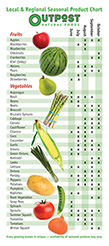Squash
Winter Squash!
Keep in mind winter squash is more than just a delicious side dish. It boasts ten times the vitamin A content of its summer squash relatives. The ample amount of soluble and insoluble fiber in winter squash may help to regulate cholesterol levels. These vine grown beauties also offer good amounts of B vitamins, vitamin C, magnesium, potassium and iron. Pumpkin and butternut squash offer the added benefits of beta-carotene, those healthy yellow-orange pigments that defend the body's cells against disease-causing free radicals. Bottom line? Winter squash is squashtastic!
General preparation tips
Winter squash is generally prepared by cutting them in half, removing the fibrous matter and seeds from the center and then steaming, microwaving or baking them. Squash with the deepest colored flesh are usually the sweetest. Most winter squash varieties can be used interchangeably in recipes, where their sweet moist flesh adds color and flavor to baked goods, custards, souffles, soups, spread and pies. For those with young children, pureed and strained squash makes an excellent baby food.
Basic cooking for small to medium squash
Baking
- Bake whole for maximum flavor and the most uniform consistency
- Set on baking sheet in a 300° preheated oven, allowing a minimum 25 minutes for 1 - 1 1/2 pound squash and maximum 2 hours for a 3 pounder
- Pierce with a knife tip; squash is done when tender
- When squash is done, halve and remove seeds and fiber
- Squash can be halved before baking. Scrape out seeds and fiber and set cut side up on a baking dish. Season and butter or oil the flesh. Cover with foil. Bake until tender.
Steaming
- Steam very hard, dry starchy squashes as well as spaghetti squash
- Set halved, seeded squash cut side down on steaming rack over salted boiling water. Cover; steam until tender 15 - 30 minutes depending on the variety
- Squash can also be steamed by cleaning and cutting into 1/2 to 3/4 inch thick rings; steam about 10 minutes, 15 minutes for pieces thicker than 2 inches
Microwave
- Microwave for a spontaneous, quick-and-easy side dish
- Arrange cleaned, seasoned squash in microwavable dish in about 1/2 inch of water
- Cover, cook until tender
- For 1 - 1 1/2 pounds of squash, cook 5 - 8 minutes
- For 2 - 3 pounds of squash, cook 12 - 16 minutes
Acorn
This workhorse of the squash world is shaped like a giant ribbed acorn with a definite pointed end. These squash have a slightly dry, orange colored flesh with a nut-like flavor. The large seed cavities are perfect for stuffing. Acorn squash is best when baked.
Butternut
Butternut squash is reminiscent of a peanut in shape and color, with a large round fleshy bottom that encloses the seeds and a cylindrical upper part that is solid flesh. The smooth hard skin is a deep butterscotch color. Small butternuts are especially sweet and because their skins are thinner, can be cooked and pureed with the skins intact. Steamed or baked like other squash, they make excellent single servings when cut in half, baked and served with butter or olive oil and maple syrup.
Delicata
Delicata squash is elongated in shape with green and tan striped textured skin. The are the size and shape of a large cucumber. Delicatas have a moist, creamy yellow flesh that tastes and smells like a blend of corn, butternut squash and sweet potato. Younger delicatas may have skins tender enough to eat once cooked. They are bet when steamed or baked, and are not recommended for soups or baking into desserts.
Kabocha
Kabocha squash resemble the "buttercup"of Turban shaped squash with their flattened drum or turban-like appearance. Kabochas has mustard yellow flesh that is sweet and rich-tasting with a texture balanced between a sweet potato and pumpkin. They are almost without fibers and have the highest sugar content of any squash. Kabochas are excellent baked with butter or oil and served as a side dish or stuffed and served as a main course.
Spaghetti
Spaghetti squash is a large oblong squash with smooth lemon-yellow skin. When cooked the creamy golden flesh separates into firm but tender spaghetti-like strands. The taste is quite nondescript thought lightly sweet and fresh. Its light squash flavor goes perfect with pasta sauces, hence its name. larger spaghetti squash have a more distinct flavor and thicker strands.
Turban (Buttercup)
Turban squash is hard and thin-skinned with a dark blue-green skin with red-orange flecks and stripes. The bright orange flesh is tender, sweet and custard smooth when steamed. Baked turban squash is more dense and dry and may be used in any manner you would butternut or acorn squash.
Sweet Dumpling
Sweet dumpling squash is small, rounded squash usually about 1/2 pound in weight. They are cream colored with shallow lobes that are striped ivy-green. Their pale yellow flesh is smooth-textured, fine and dry as a potato, with light to medium sweetness and a slight corn flavor. They are delicious when steamed or baked. The skin is relatively tender and can be eaten!
Hubbard
Hubbard squash is variable in appearance but usually green or grey with an orange blush and shaped like a teardrop. They can be used in soup, purees, stews or pies. Hubbards range in size from big to enormous - best bet is to peel, seed and cube before roasting, boiling or steaming.








